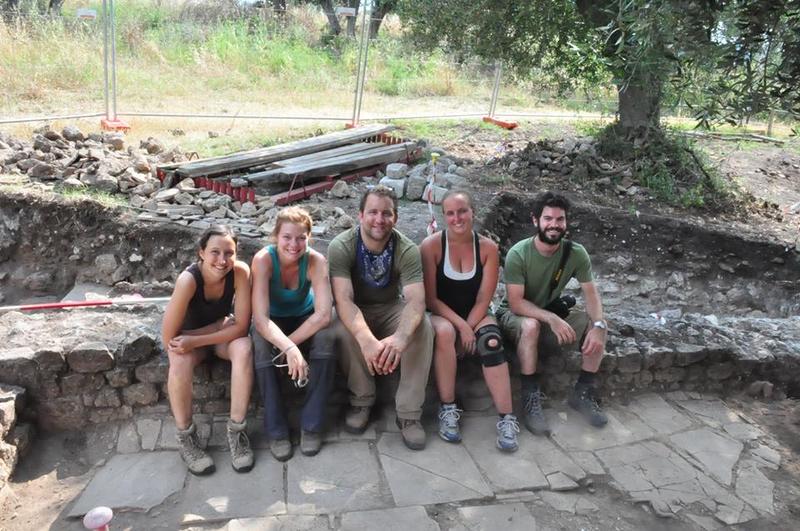May 7, 2014

Ann Glennie and Allison Smith became interested in the study of archaeology before college, but it was under the influence of great professors at the College of William and Mary and the University of North Carolina at Chapel Hill respectively that they both discovered the desire to pursue archaeology as a career. The Archaeological Institute of America saw their passion for classical archaeology at the 2014 Annual Meeting in Chicago, where they won the award for “Best Poster Designed Entirely by Students,” for a poster created with colleagues about excavations at the site of Cosa (near the modern village of Ansedonia, Italy). Currently, they are both first-year Ph.D. students at Florida State University, continuing their fascinating projects and staying involved with the AIA.
 Allison’s first excavation, following her sophomore year of college, was at Carsulae, in Umbria, where she worked on a bath complex. Recently, excavations at Cosa have also opened on a bath complex. These experiences greatly influenced Allison’s interest in “Republican and Imperial bathing complexes and the hydraulics/engineering behind those structures.” Although it is too early in her studies to say for sure, Allison is hoping to incorporate her first-hand experiences at Cosa into her future dissertation. Once she earns her degree, she is looking forward to passing on her interests in Roman architecture and art to “fellow and future archaeologists,” while continuing to explore those fields.
Allison’s first excavation, following her sophomore year of college, was at Carsulae, in Umbria, where she worked on a bath complex. Recently, excavations at Cosa have also opened on a bath complex. These experiences greatly influenced Allison’s interest in “Republican and Imperial bathing complexes and the hydraulics/engineering behind those structures.” Although it is too early in her studies to say for sure, Allison is hoping to incorporate her first-hand experiences at Cosa into her future dissertation. Once she earns her degree, she is looking forward to passing on her interests in Roman architecture and art to “fellow and future archaeologists,” while continuing to explore those fields.
.jpg)
As an undergraduate, Ann turned to the AIA website for field school ideas, and discovered the Etruscan Poggio Civitate field school in Murlo, Italy. She has been involved with that school for seven years and is currently a staff member there, in addition to her graduate work at Cosa. Her advisor John Donahue first encouraged Ann to join the AIA, and she cites him as one of the “great professors and mentors,” at William and Mary. Ann has attended the Annual Meeting every year since 2010, and says that she has “thoroughly enjoyed the opportunity to present my work and learn about the research of others.” Now working under Andrea De Giorgi, director of the Cosa excavations, Ann hopes to focus on pre-Roman activity at the site.
The AIA’s Tallahassee Society has many members from Florida State University, and Ann and Allison enjoy attending the varied lectures and events. Allison believes that “archaeology is becoming more accessible to the public,” and that archaeologists and the AIA “should continue as a community to provide good sources of public outreach and information.” In line with AIA’s mission, Ann feels that “site preservation is incredibly important,” and also supports “getting site reports out as soon as possible, creating user friendly databases, employing open source types of technologies…” to encourage sharing with the archaeological community and greater public. These passionate graduate students have a very positive vision for the future of the archaeology, and the AIA is looking forward to hearing about their future projects.
The AIA offers grants for students traveling to the Annual Meeting, along with many other opportunities. To support student posters, presentations and publications, make your gift here.
Ann and Allison have embraced crowdfunding to help support the work at Cosa. You can learn more about and support Allison’s project, “An Archaeological Excavation of a Roman Bath Complex,” by clicking here. Ann has recently completed a successful fundraising campaign, “Help Excavate Cosa’s East Terminal Wall,” details of which are still available here.
For information on all the benefits of AIA membership, including discounted registration at the Annual Meeting, please contact Deanna Baker at 617-353-8705 or dbaker@aia.bu.edu.
If you are a graduate student, and current member of the AIA, who would like to be featured on the AIA website, please contact Emily Maskas at 617-353-8703 or emaskas@aia.bu.edu.